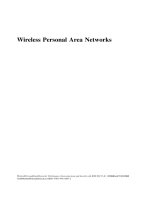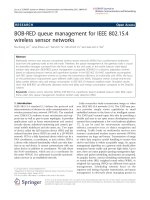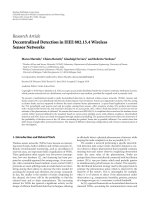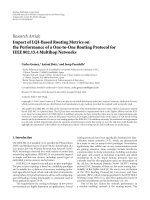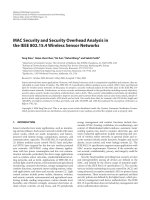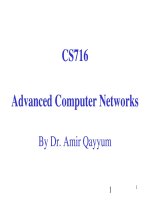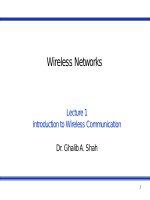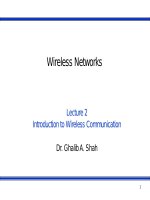Wireless networks - Lecture 41: IEEE 802.15.4/ZigBee
Bạn đang xem bản rút gọn của tài liệu. Xem và tải ngay bản đầy đủ của tài liệu tại đây (393.52 KB, 29 trang )
Wireless Networks
Lecture 41
IEEE 802.15.4/ZigBee
Dr. Ghalib A. Shah
1
Outlines
Overview of ZigBee
► Whats is ZigBee, Zigbee in Wireless World,
Architecture, Characteristics
IEEE 802.15.4
►
►
►
►
Basics, Type of Devices
Topology, Addressing
Phy Layer
Channel Access Mechanisms
• Slotted/Unslotted CSMA/CA
► Data Transfer Model
► Superframe Structure
2
Last Lecture
IP Over Bluetooth
Bluetooth Security
WPAN Standards
IEEE 802.15.3 Overview
802.15.3
►
►
Topology
Coordination
•
•
•
•
•
►
►
►
►
Starting a Piconet
Handing over control of piconet
Creating child piconet
Ending a Piconent
Association/Disassociation
Medium Access (Superframe)
Channel Time Management
Power management
MAC Frame format
3
What is ZigBee Alliance?
An organization with a mission to define
reliable, cost effective, low-power, wirelessly
networked, monitoring and control products
based on an open global standard
The alliance provides interoperability,
certification testing, and branding.
4
IEEE 802.15.4: What is ZigBee?
A standard for mesh networking
►
Designed for low power applications
►
20-250Kb/sec (depending on band)
Very Secure
►
Very long battery life
Low data rate
►
Reliability through meshed connectivity
AES-128 encryption available
Self configuring
►
►
Allows ad hoc networks
Ease of installation and configuration
5
ZigBee in the wireless world
Chart Copyright ZigBee Alliance 2004
6
ZigBee/IEEE 802.15.4 Market Feature
Low power consumption
Low cost
Low offered message throughput
Supports large network orders (<=65k nodes)
Low to no QoS guarantees
Flexible protocol design suitable for many
applications
7
ZigBee Target Markets
Security
HVAC
TV
AMR
VCR
Lighting Control
DVD/CD
Access Control
BUILDING
AUTOMATION
CONSUMER
ELECTRONICS
Patient
monitoring
ZigBee
Fitness
monitoring
Wireless Control that
Simply Works
PERSONAL
HEALTH CARE
RF Remotes
PC &
PERIPHERALS
Security
Asset Mgt
Process
Control
INDUSTRIAL
CONTROL
RESIDENTIAL/
LIGHT
COMMERCIAL
CONTROL
Environmental
Energy Mgt
HVAC
Lighting Control
Access Control
Lawn & Garden
Irrigation
Chart Copyright ZigBee Alliance 2004
8
ZigBee/802.15.4 Architecture
9
ZigBee/802.15.4 Technology: General
Characteristics
Data rates of 250 kbps , 20 kbps and 40kpbs.
Star or Peer-to-Peer operation.
Support for low latency devices.
CSMA-CA channel access.
Dynamic device addressing.
16 channels in the 2.4GHz ISM band, 10
channels in the 915MHz ISM band and one
channel in the European 868MHz band.
10
IEEE 802.15.4 Basics
802.15.4 is a simple packet data protocol for
lightweight wireless networks
► Channel Access is via Carrier Sense Multiple
Access with collision avoidance and optional time
slotting
11
IEEE 802.15.4 Device Types
There are two different device types :
► A full function device (FFD)
► A reduced function device (RFD)
The FFD can operate in three modes serving
► Device
► Coordinator
► PAN coordinator
The RFD can only operate in a mode serving:
► Device
12
FFD vs RFD
Full function device (FFD)
► Any topology
► Network coordinator capable
► Talks to any other device
Reduced function device (RFD)
13
Star Topology
Network
coordinator
Master/slave
Full Function Device (FFD)
Reduced Function Device (RFD)
Communications Flow
14
Peer-Peer Topology
Point to point
Tree
Full Function Device (FFD)
Communications Flow
15
Combined Topology
Full Function Device (FFD)
Reduced Function Device (RFD)
Communications Flow
16
Extending ZigBee Networks
ZED (Zig Be e Exte ns io n De vic e )
►
J oins two or more radio disjoint PANs
Provides a “wormhole” within a single
PAN
►
A ZigBee router with a wire interface
A low cost, high reliability link within the
radio network
ZED
ZED
PAN A
PAN A
Coordinator A
“Extends” the ZigBee network layer
ZED
Coordinator B
17
PAN B
ZED
Device Addressing
Each independent PAN will select a unique
PAN identifier
Addressing modes:
► star: Network (64 bits) +device identifier (16 bits)
► peer-to-peer: Source/destination identifier (64 bits)
18
IEEE 802.15.4 PHY Overview
PHY functionalities:
►
►
►
►
►
►
Activation and deactivation of the radio transceiver
Energy detection within the current channel
Link quality indication for received packets
Clear channel assessment for CSMA-CA
Channel frequency selection
Data transmission and reception
19
IEEE 802.15.4 PHY Overview
Operating Frequency Bands
868MHz/
915MHz
PHY
Channel 0
868.3 MHz
2.4 GHz
PHY
Channels 1-10
902 MHz
Channels 11-26
2 MHz
928 MHz
5 MHz
2.4 GHz
2.4835 GHz
20
Frequency Bands and Data Rates
The standard specifies two PHYs :
► 868 MHz/915 MHz direct sequence spread spectrum
(DSSS) PHY (11 channels)
• 1 channel (20Kb/s) in European 868MHz band
• 10 channels (40Kb/s) in 915 (902-928)MHz ISM band
► 2450 MHz direct sequence spread spectrum (DSSS)
PHY (16 channels)
• 16 channels (250Kb/s) in 2.4GHz band
21
General Radio Specifications
Transmit Power
► Capable of at least –3dBm
Receiver Sensitivity
► -85 dBm (2.4GHz) / -91dBm (868/915MHz)
Link quality indication
► The measurement may be implemented using
• Signal to noise ratio estimation
• Receiver energy detection
22
Channel Access Mechanism
Two type channel access mechanism, based
on the network configuration:
► In non-beacon-enabled networks unslotted
CSMA/CA channel access mechanism
► In beacon-enabled networks slotted CSMA/CA
channel access mechanism
• The super frame structure will be used.
23
CSMA/CA Algorithm
Each device shall maintain three variables for
each transmission attempt
► NB: number of slots the CSMA/CA algorithm is
required to backoff while attempting the current
transmission.
► BE: the backoff exponent which is related to how
many backoff periods a device shall wait before
attempting to assess a channel
► CW: (a special design)
24
Data Transfer Model
Data transferred from device to coordinator
Network
Device
Coordinator
Beacon
Data
Acknowledgement
Network
Device
Coordinator
Data
Acknowledgement
(Optional)
(Optional)
Communication to a coordinator
In a beacon-enabled network
Communication to a coordinator
In a non beacon-enabled network
25
